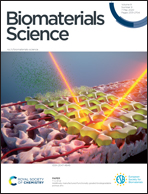Spatial immobilization of endogenous growth factors to control vascularization in bone tissue engineering
Abstract
The intimate crosstalk between endothelial and bony cells is essential for the reconstruction of bone tissue defects. Indeed, a successful bone repair is greatly dependent on the formation of new blood vessels, to ensure the supply of nutrients and gases, as well as the removal of metabolites. Bone morphogenetic proteins (BMPs) and vascular endothelial growth factor (VEGF) are involved on cells differentiation and bone vascularization aiming to develop viable bone tissue. Herein it is hypothesized that endogenous BMP-2 and VEGF bound in a parallel arrangement over a single nanofibrous substrate (NFM) can lead to a successful osteogenic and angiogenic differentiation of mesenchymal stem cells. For that, an engineered biofunctional system was developed comprising anti-BMP-2 and anti-VEGF antibodies, immobilized over an electrospun NFMs in a parallel pattern design, with the attempt to recreate the vasculature of bone tissue. The osteogenic and angiogenic potential of this engineered biofunctional system was demonstrated by culturing human bone marrow-derived mesenchymal stem cells (hBM-MSCs) during 21 days without exogenous induction. A chick chorioallantoic membrane (CAM) assay showed that the engineered biofunctional system, comprising bound endogenous BMP-2 and VEGF, is able to induce an increased angiogenic response. The angiogenic ability of this system, together with the osteogenic inductor BMP-2, enable obtaining an effective vascularized bone tissue engineering approach.



 Please wait while we load your content...
Please wait while we load your content...